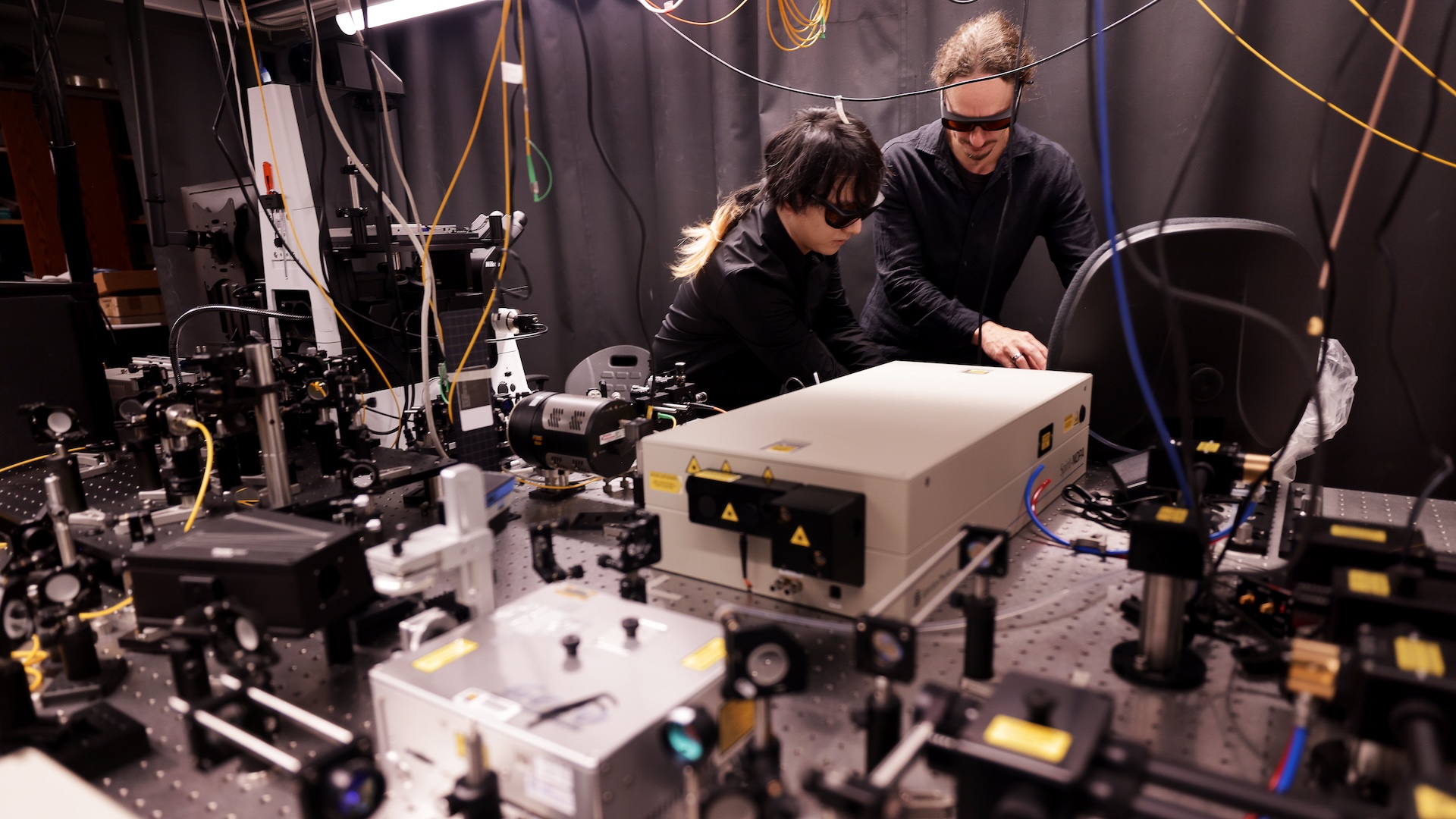Electronics breakthrough means our devices may one day no longer emit waste heat, scientists say
By Tristan Greene
Copyright livescience

Skip to main content
Close main menu
Live Science
Sign up to our newsletter
View Profile
Search Live Science
Planet Earth
Archaeology
Physics & Math
Human Behavior
Science news
Life’s Little Mysteries
Science quizzes
Newsletters
Story archive
‘Halo’ barrels off Los Angeles
Bright orange shark discovered
Visible time crystal created
Michael Osterholm on the next pandemic
Giant ‘chessboard’ surrounds Idaho river
Don’t miss these
Electronics
Quantum materials with a ‘hidden metallic state’ could make electronics 1,000 times faster
Microsoft’s new light-based computer is inspired by 80-year-old technology — it could make AI 100 times more efficient
Scientists use quantum machine learning to create semiconductors for the first time – and it could transform how chips are made
Small, room-temperature quantum computers that use light on the horizon after breakthrough, scientists say
Millions of qubits on a single quantum processor now possible after cryogenic breakthrough
Breakthrough quantum computer could solve problems 200 times faster than a supercomputer
Electronics
Scientists invent weird, shape-shifting ‘electronic ink’ that could give rise to a new generation of flexible gadgets
Physics & Mathematics
Meet the ‘neglectons’: Previously overlooked particles that could revolutionize quantum computing
Electronics
New liquid metal-infused circuit board can withstand heavy damage and heal by themselves
‘Quantum AI’ algorithms already outpace the fastest supercomputers, study says
Electronics
Laser-blasted ‘black metal’ could make solar technology 15 times more efficient
Scientists hit quantum computer error rate of 0.000015% — a world record achievement that could lead to smaller and faster machines
Scientists achieve ‘magic state’ quantum computing breakthrough 20 years in the making
Microsoft breakthrough could reduce errors in quantum computers by 1,000 times
Your household gadgets could soon be battery-free — scientists create tiny solar cells that can be powered by indoor light
Electronics
Electronics breakthrough means our devices may one day no longer emit waste heat, scientists say
Tristan Greene
10 September 2025
A new “optoexcitonic switch” already achieves state-of-the-art performance over current electronics and could serve as the basis for classical and quantum computing devices capable of operating at room temperature.
When you purchase through links on our site, we may earn an affiliate commission. Here’s how it works.
Zhaohan Jiang, a Ph.D. student in electrical and computer engineering, and Matthias Florian, research investigator in the electrical engineering and computer science department, prepare for a laser experiment in the Excitonics and Photonics (ExP) Lab.
(Image credit: Brenda Ahearn/University of Michigan, College of Engineering, Communications and Marketing)
Researchers have developed a breakthrough technology that solves a fundamental limit in electronics.
This new technology, dubbed an “optoexcitonic switch,” could lead to a new class of electronics — ranging from phones and PCs to data centers and quantum computers that can operate at without generating waste heat.
The new switch works like a conventional electronic switch, which uses an electrical charge to control the flow of electrons in a system. Switches direct the flow of energy or control the transmission of signals in a device.
You may like
Quantum materials with a ‘hidden metallic state’ could make electronics 1,000 times faster
Microsoft’s new light-based computer is inspired by 80-year-old technology — it could make AI 100 times more efficient
Scientists use quantum machine learning to create semiconductors for the first time – and it could transform how chips are made
Because these electrons are charged, they produce “waste heat.” This is why your laptop gets hot when you play a demanding video game and why massive data centers operate at extraordinarily high temperatures.
The new “excitonic switches,” on the other hand, rely on neutrally charged “excitons” — a class of quasiparticles created by “exciting” an electron in such a way that it’s removed from its position within an atom.
These excited electrons leave behind a hole that binds with the free electron. Together, the free-moving electron, which now has a negative charge, and the hole it leaves behind, which has a positive charge, form a single quasiparticle called an “exciton” that remains neutrally charged. As excitons have a neutral charge, they don’t produce heat when they transfer information.
The power of light
The breakthrough research, published Aug. 31 in the journal ACS Nano, is the first time excitons have been used to create a switch that exceeds the performance of current photonic switches and achieves overall state-of-the-art performance.
Sign up for the Live Science daily newsletter now
Get the world’s most fascinating discoveries delivered straight to your inbox.
Contact me with news and offers from other Future brandsReceive email from us on behalf of our trusted partners or sponsorsBy submitting your information you agree to the Terms & Conditions and Privacy Policy and are aged 16 or over.
“Electronics get hot, and that’s because electronic devices always have capacitors,” study co-author Parag Deotore, associate professor electrical engineering, computer engineering, and applied physics, told Live Science. “Every time you store energy or you release that energy, you heat it up. An exciton is a new charge-neutral particle, like a photon, that doesn’t produce this heat.”
The new device uses excitons to overcome the heat problem and improves on the electronic design by shrinking the switches used to move information by two orders of magnitude.
Deotore said the long-term goal in developing these new switches is to create excitonic circuits that function so efficiently that computer systems don’t need fans and that phones can keep their batteries charged for far longer periods of time.
Testing the ‘magical thickness’
While the theory behind excitonic switches is sound, engineering and testing the new technology presented the biggest challenge for the team. In a conventional electronic system, electrons are pushed where they need to go through a brute-force electrical charge. Excitons lack this option because of their neutral charge.
To get excitons to go where they need to go, the scientists used similarly neutrally charged photons to order the excitons in a linear array along a one-dimensional plane — or “ridge.”
The team created the excitons, then affected them with a specific number of photons, which were absorbed at the tip of the ridge to create an exciton population, Deotore said. In other words, this is a crowd of excitons bunched up and standing still at the bottom of a straight line. The team then applied more photons until the excitons began to move. If they added too many photons, the excitons failed to follow the ridge; too few photons caused the excitons to remain still.
“Our prediction was that if you grow them thick enough, the light coupling to excitons will be such that the push is going to be destroyed. And they could show it. So basically, it had to have a magical thickness,” study co-author Mackillo Kira, a professor of electrical and computer engineering, and the co-director of the university’s Quantum Research Institute, told Live Science.”
Because light acts as a wave, the photons “pushed” the excitons once that magical thickness was achieved. Observing this activity confirmed the theories and proved that the experiment was a success, Kira added. “That’s actually easy to verify for experiments, because the color of the exciton will change as you go along the ridge, Kira said.
Based on the results of the experiment, the switch already meets or exceeds the capabilities of current technology.
RELATED STORIES
—Newly discovered quantum state could power more stable quantum computers — and a new 2D chip can tap into it
—Quantum ‘miracle material’ can store information in a single dimension thanks to newly discovered magnetic switching
—Scientists watch a single electron move during a chemical reaction for first time ever
The ultimate goal is to scale these switches into circuits that would, ostensibly, replace current electronics. According to the researchers, several advances are necessary to reach that goal, including finding new materials and developing techniques to fabricate and scale the prototype devices used in the team’s experiments. But the team believes these challenges could be overcome in a matter of decades.
The hope is that optoexcitonic switches and circuits could overcome waste heat — arguably the biggest problem in computing. This would enable massive reductions in size coupled with exponential improvements in performance, the scientists said.
Tristan Greene
Tristan is a U.S-based science and technology journalist. He covers artificial intelligence (AI), theoretical physics, and cutting-edge technology stories.
His work has been published in numerous outlets including Mother Jones, The Stack, The Next Web, and Undark Magazine.
Prior to journalism, Tristan served in the US Navy for 10 years as a programmer and engineer. When he isn’t writing, he enjoys gaming with his wife and studying military history.
You must confirm your public display name before commenting
Please logout and then login again, you will then be prompted to enter your display name.
Quantum materials with a ‘hidden metallic state’ could make electronics 1,000 times faster
Microsoft’s new light-based computer is inspired by 80-year-old technology — it could make AI 100 times more efficient
Scientists use quantum machine learning to create semiconductors for the first time – and it could transform how chips are made
Small, room-temperature quantum computers that use light on the horizon after breakthrough, scientists say
Millions of qubits on a single quantum processor now possible after cryogenic breakthrough
Breakthrough quantum computer could solve problems 200 times faster than a supercomputer
Latest in Electronics
Laser-blasted ‘black metal’ could make solar technology 15 times more efficient
Quantum materials with a ‘hidden metallic state’ could make electronics 1,000 times faster
New liquid metal-infused circuit board can withstand heavy damage and heal by themselves
Scientists invent weird, shape-shifting ‘electronic ink’ that could give rise to a new generation of flexible gadgets
China’s ‘2D’ chip could soon be used to make silicon-free chips
What is Moore’s Law?
Latest in News
Electronics breakthrough means our devices may one day no longer emit waste heat, scientists say
‘Incredibly exciting’: NASA claims it’s found the ‘clearest sign’ yet of past life on Mars
Scientists find baby pterosaurs died in violent Jurassic storm 150 million years ago
Canada’s 2023 wildfires contributed to 87,000 early deaths worldwide, study estimates
Ancient DNA from Mexico’s mammoths reveals unexpected — and unexplained — genetic mysteries
Confirmed! Black hole merger shows Stephen Hawking theory was right
LATEST ARTICLES
‘Incredibly exciting’: NASA claims it’s found the ‘clearest sign’ yet of past life on Mars
‘Our hearts stopped’: Scientists find baby pterosaurs died in violent Jurassic storm 150 million years ago
Olympus OM-D E-M10 Mark IV review
Canada’s 2023 wildfires contributed to 87,000 early deaths worldwide, study estimates
Ancient DNA from Mexico’s mammoths reveals unexpected — and unexplained — genetic mysteries
Live Science is part of Future US Inc, an international media group and leading digital publisher. Visit our corporate site.
Contact Future’s experts
Terms and conditions
Privacy policy
Cookies policy
Accessibility Statement
Advertise with us
Web notifications
Editorial standards
How to pitch a story to us
Future US, Inc. Full 7th Floor, 130 West 42nd Street,
Please login or signup to comment
Please wait…



